1980 CHEVROLET CITATION maintenance
[x] Cancel search: maintenancePage 1 of 95

Downloaded from www.Manualslib.com manuals search engine 1980
CHEVROLET
OWNER'S MANUAL
Contains Important Operating,
Safety and Maintenance Instructions.
Keep with car at all times.
Page 3 of 95
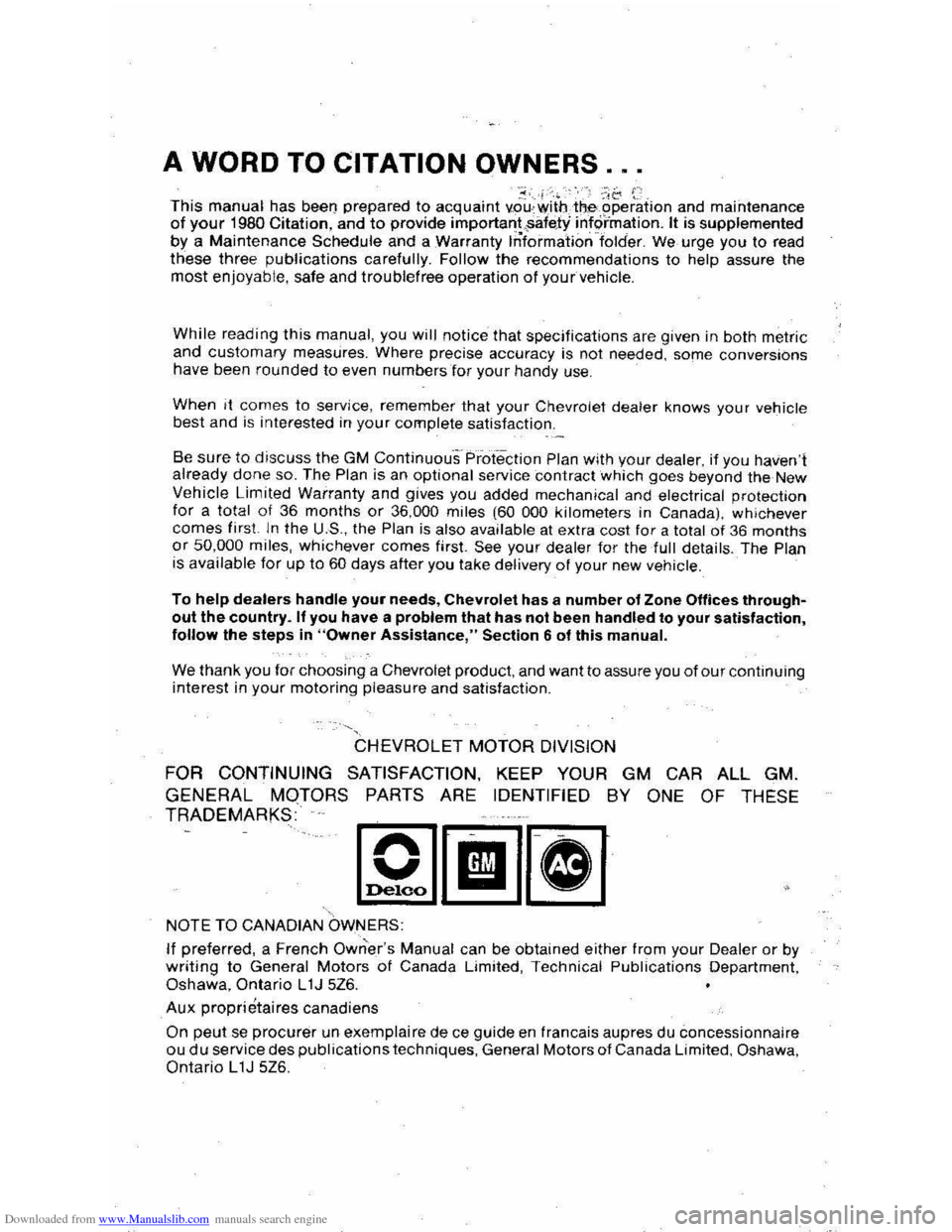
Downloaded from www.Manualslib.com manuals search engine A WORD TO CITATION OWNERS
:;':'.'1'.;.-:,-, 32 ~ This manual has beet} prepared to acquaint vou-:withtheoperation and maintenance of your 1980 Citation, and to provide importa~t~afeJY infc?rmation. It is supplemented by a Maintenance Schedule and a Warranty Information folder. We urge you to read these three publications carefully. Follow the recommendations to help assure the most enjoyable, safe and troublefree operation of your vehicle.
While reading this manual, you will notice that specifications are given in both metric and customary measures. Where precise accuracy is not needed, some conversions
have been rounded to even numbers for your handy use.
When it comes to service, remember that your Chevrolet dealer knows your vehicle
best and is interested in your complete satisfaction.
Be
sure to discuss the GM Continuou's'Protection Plan with your dealer, if you haven't already done so. The Plan is an optional service contract which goes beyond the New Vehicle Limited Warranty and gives you added mechanical and electrical protection for a total of 36 months or 36,000 miles (60 000 kilometers in Canada), whichever comes first. In the U.S., the Plan is also available at extra cost for a total of 36 months or 50,000 miles, whichever comes first See your dealer for the full details. The Plan is available for up to 60 days after you take delivery of your new vehicle.
To help dealers handle your needs, Chevrolet has a number of Zone Offices throughout the country. If you have a problem that has not been handled to your satisfaction, follow the steps in "Owner Assistance," Section 6 of this manual.
We thank you for choosing a Chevrolet product, and want to assure you of our continuing interest in your motoring pleasure and satisfaction.
CHEVROLET MOTOR DIVISION
FOR CONTINUING SATISFACTION,
KEEP YOUR GM CAR ALL GM.
GENERAL
MOTORS PARTS ARE IDENTIFIED BY ONE OF THESE TRADEMARKS:
NOTE TO CANADIAN OWNERS:
If preferred, a French Owner's Manual can be obtained either from your Dealer or by writing to General Motors of Canada Limited, Technical Publications Department, Oshawa, Ontario L1J 5Z6.
Aux propriehaires canadiens
On peut se procurer un exemplaire de ce guide en francais aupres du concessionnaire ou du service des publications techniques, General Motors of Canada Limited, Oshawa, Ontario L 1J 5Z6.
Page 4 of 95
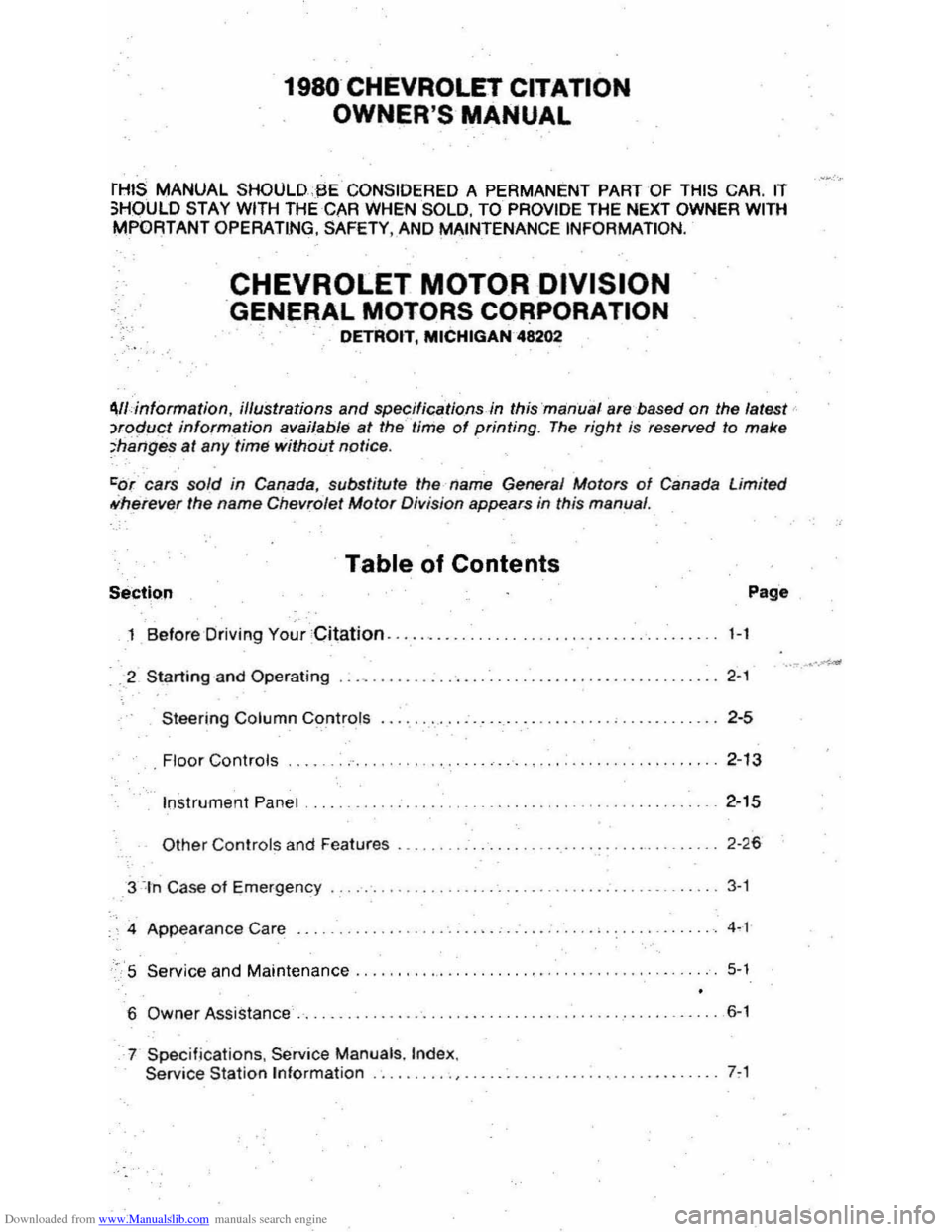
Downloaded from www.Manualslib.com manuals search engine 1980 CHEVROLET CITATION
OWNER'S
MANUAL
rHIS "lANUAL SHOULDSE CONSIDERED A PERMANENT PART OF THIS CAR. IT 3HOULD STAY WITH THE CAR WHEN SOLD. TO PROVIDE THE NEXT OWNER WITH "lPORTANT OPERATING. SAFETY. AND MAINTENANCE INFORMATION.
CHEVROLET MOTOR DIVISION
GENERAL MOTORS CORPORATION
DETROIT, MICHIGAN 48202
4lrinformatlon, illustrations and specifications in thisma'n 'ual are ' based on the latest t. )roduct information available at the time of printing. The right is rese rved to make ~hanges at any time without notice.
Co" cars sold in Canada , substitute the name General Motors of Canada Limited ",herever the name Chevro-'et Motor D;vision appears in this manual.
Table of Contents
Section
.1 Before Driving Your · Citation .... . ,-,
-__ 2 Starting and Operating .. . ..... 2-'
Steering Column Contr~!s 2-5
.
Floor Controls .. 2-13
Instrument Panel 2-15
Other Controls and Features . 2-26
3--'ln Case of Emergency . 3-1
4 Appearance Care .. ..... 4-'
:' 5 Service and Maintenance 5-'
6 Owner Assistance. 6-1
7 Specifications, service Manuals , Ind ex, Service Station Information .... ". _ .... , ................... 7~ 1
Page 5 of 95
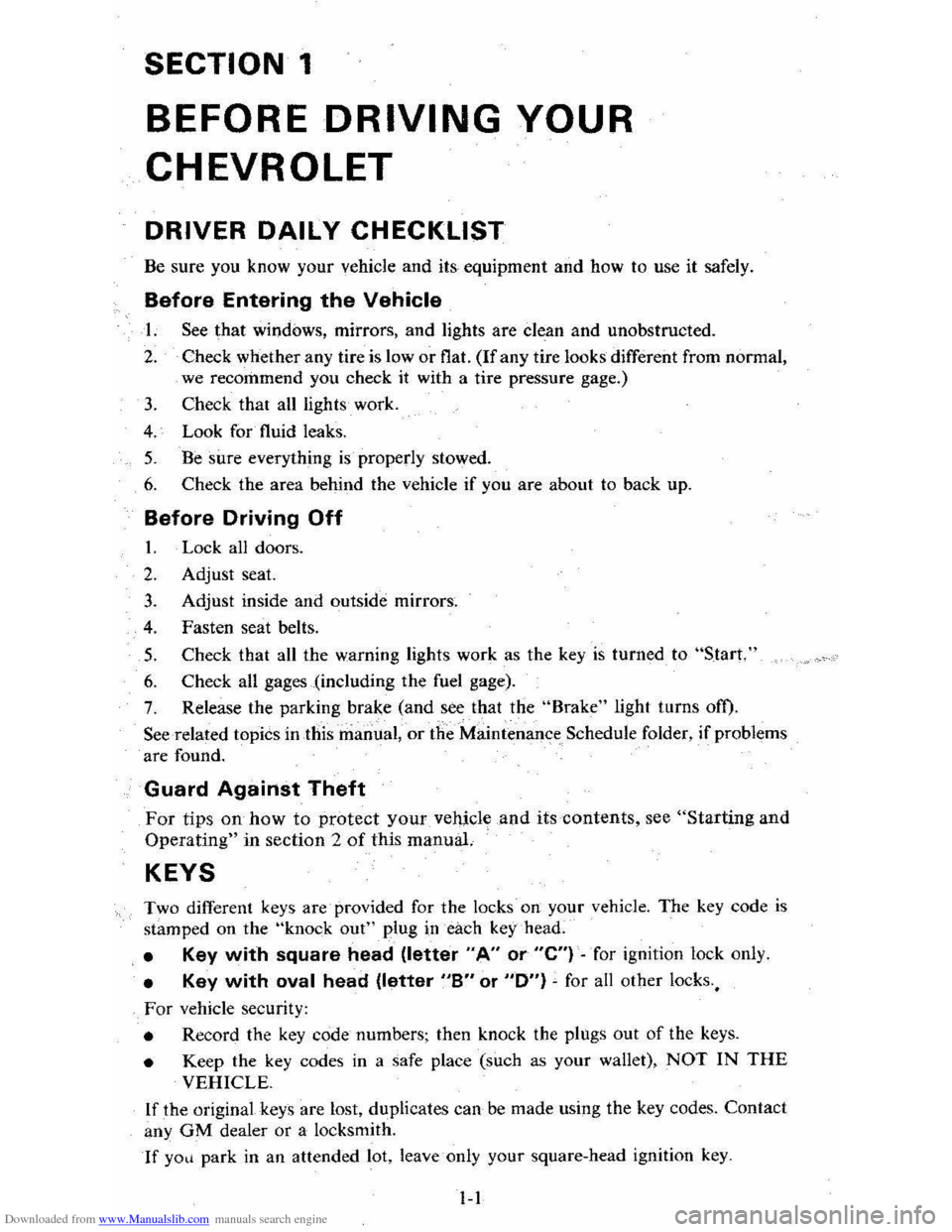
Downloaded from www.Manualslib.com manuals search engine SECTION 1
BEFORE DRIVING YOUR
CHEVROLET
DRIVER DAILY CHECKLIST
Be sure you know your vehicle and its, equipment and how to use it safely.
Before Entering the Vehicle
1. See that windows, mirrors, and lights are clean and unobstructed.
2. Check whether any tire is low or flat. (If any tire looks different from nonnal,
we recommend you check
it with a tire pressure gage.)
3. Check that all lights work.
4. Look for fluid leaks.
5. Be sure everything is properly stowed.
6. Check the area behind the vehicle if you are about to back up.
Before Driving Off
1. Lock all doors.
2. Adjust seat.
3. Adjust inside and outside mirrors.
4. Fasten seat belts.
5. Check that all the warning lights work as the key is turned to "'Start."
6. Check all gages (including the fuel gage).
7. Release the parking brake (and see that the "Brake" light turns om.
Seerelated topics in this manual, or the Maintenance Schedule folder, if problems
are found.
Guard Against Theft
For tips on how to protect your vehicle and its contents, see "Starting and
Operating" in section 2 of this manuaL
KEYS
Two different keys are· provided for the locks on your vehicle. The key code is
stamped on the "knock out" plug in each key head.
• Key with square head (letter "A" or "e") -for ignition lock only.
• Key with oval head (letter "8" or "0") ~ for all other locks.,
For vehicle security:
• Record the key code numbers; then knock the plugs out of the keys.
• Keep the key codes in a safe place (such as your wallet), NOT IN THE
VEHICLE.
If the original keys are lost, duplicates can
be made using the key codes. Contact
any
OM dealer or a locksmith.
If yO~i park in an attended lot, leave only your square-head ignition key.
1-1
Page 16 of 95
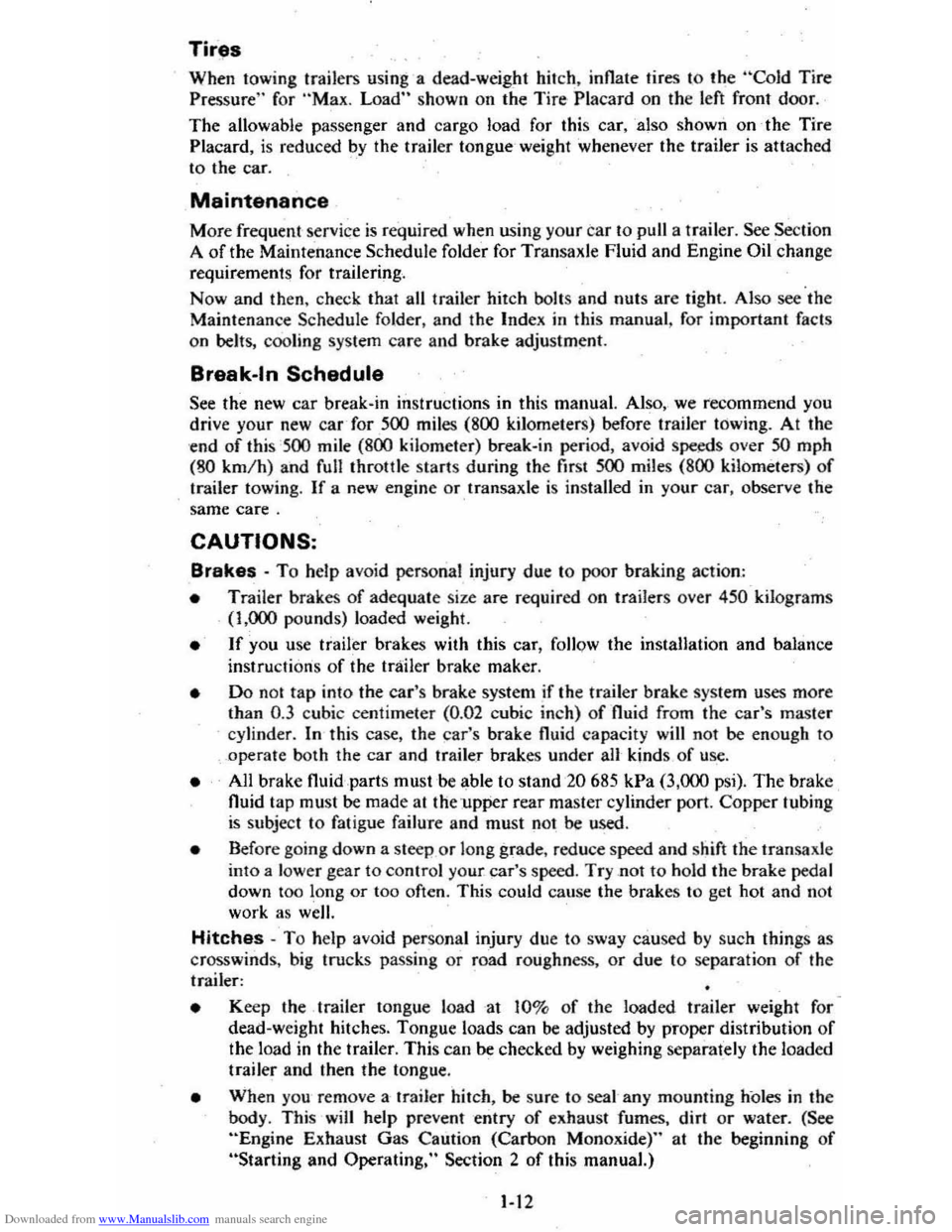
Downloaded from www.Manualslib.com manuals search engine Tir,s
When lowing trailers using a dead-weight hitch, inflate tires to the "Cold Tire
Pressure" for ·'Max . Load" show n on the Tire Placard on the left front door.
The allowable passenger and cargo load for this car,
also sh o wn on· the Tire
Placard, is reduced by the trailer tongue weight whenever the trailer is attached
t o the car.
Maintenance
More frequen.t servic e is requi red when using your car to pull a trailer. See Section
A of the Maint enance Schedule folder for Tran saxle Fluid and Engine Oil chang e
requirement~ for traitering.
Now and then. check that all trailer hitch bolts an d nuts are tight. Also see
"the Maintenance Schedule rol_def, and the Index in this manual , for important facts
o n
belts, coo ling system care and brake adjustment.
Break-In Schedule
See the new car break~in instru ctions in this manual. Also,. we recommend you
drive your new car for
500 mil es (800 kilometer s) before trailer tOwing. At the
" end
of this 500 mile (800 kilome te r) break-in period, avoid speeds over 50 mph (80 km/h) and full throttl e start s during the first 500 miles (800 kilometers) of
trailer towing.
If a new engine or transaxle is ins talled in you r car, observe the
same
care.
CAUTIONS:
Brakes -To help avoid personal injury due to poor braking action:
• Trailer brakes of adequate size are required on trailer s over 450 kilograms
(1,000 pounds) loaded weight.
• If you use trailer brakes with this car, follow the installation and balan ce
instructi ons
of the trailer brake maker.
• Do nol lap into the car's brake system if the trailer brake system uses more than 0.3 cubic centimeter (0.02 cubic inch) of nuid from the ca r's master
cylinder. In this case, the car's brake fluid capacity will not be enough to
operate
both the car and trailer brakes under all kind s, of use.
• All brak e fluid parts must be able to stand 20 685 kPa (3,000 psi). The brake
fluid tap must be made al th e upper rear master cylinder port. Copper tubing is subject to fatigue failure and must no t be used.
• Before going down a sleep or long grade , reduce speed and shift the tran saxle
into a lower gear to control your car's speed.
Try not to hold the brake pedal
down too long or too often. This could cause the brake s to get hot and not
work
as well.
Hitches -To help avoid personal injury due to sway caused by such things as
c rosswind
s, big trucks passing or road roughn ess, or due to sepa ration of the
trailer :
• Keep the trailer tongue load at 10% of the loaded trailer weight for
dead-w eight hitches. Tongue loads can be adjusted by proper distribution of the load in the trailer. This can be checked by weighing separately the loaded
trailer and then the tongue,
• When you remove a frailer hitch, be sure to seal any mountin g h'oles in the
body . This will help prevent entry of exhaust fumes, dirt or water. (See
"Engine Exhaust Gas Caution (Carbon Monoxide) " at the beginning of "Starting and Operating," Section 2 of this manual.)
1-12
Page 17 of 95
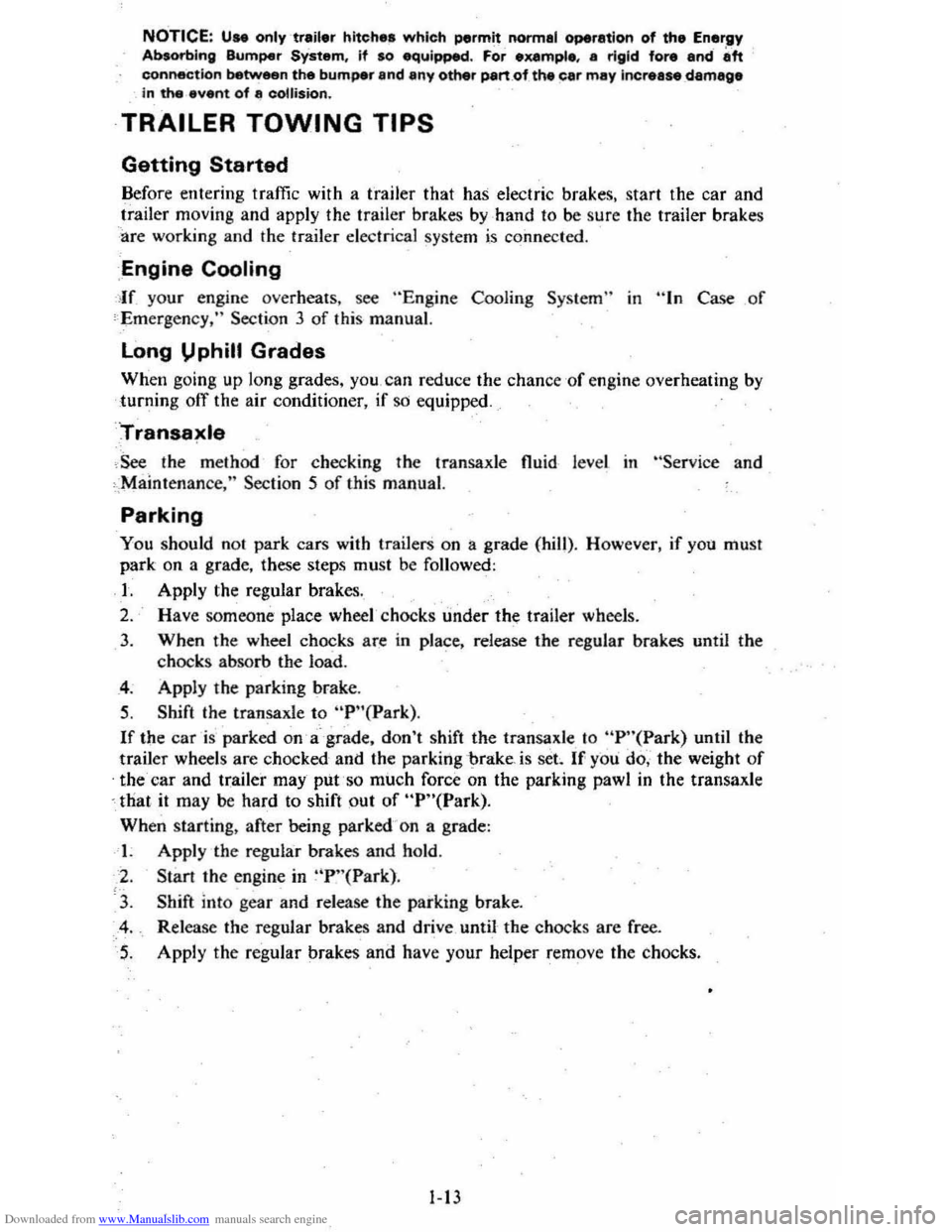
Downloaded from www.Manualslib.com manuals search engine NOTICE: Use only trailer hitches which permit normal operation of the Energy Absorbing Bumper System. if so equipped. For example. a rigid fore and .iUt connection between the bumper and any other part.of. the car may increase .damage in the event of II collision.
TRAILER TOWING TIPS
Getting Started
Before entering traffic with a frailer that has electric brakes, start the car and
trailer moving and apply the trailer brakes
by hand to be sure the trailer brakes
are working and the trailer electrical system
is connected .
. Engine Cooling
:
When going up long grades, you, can reduce the chance 'of engine overheating by
turning
off the air conditioner, if so equipped.
Transaxle
,See the method for checking the transaxle fluid le ve l. in "Service and
,.;.Maintenance," Section 5 of this manual .
Parking
You should not park cars with trailers on a grade (hill). However, if you must
park on a grade, these steps must be followed:
1. Apply the regular brakes.
2. Have someone place wheel' chocks under the trailer wheels.
3. When the wheel chocks are in place, release the regular brakes until the
chocks absorb the load .
4; Apply Ihe parking brake.
S. Shift Ihe transaxle 10 ··P"(Park).
If the car is parked on a grade. don't shift the transaxle 10 "P"(Park) until the
trailer wheels
are chocked and the parkinghrake, is set~ If you do, the weight of . the car and trailer may put so much force on the parking pawl in the transaxle
.
that it may be hard to shift oul of "P"(Park).
When starting , after being parked ' on a grade:
(; Apply the regular brakes and hold.
2 .
Stan th e engine in ··P"(Park) .
-3. Shift into gear and release the parking brake.
4. Release the regular brakes and drive until the chock s are free.
5. Apply the regular brakes and have your helper remove the chocks.
J.]3
Page 19 of 95
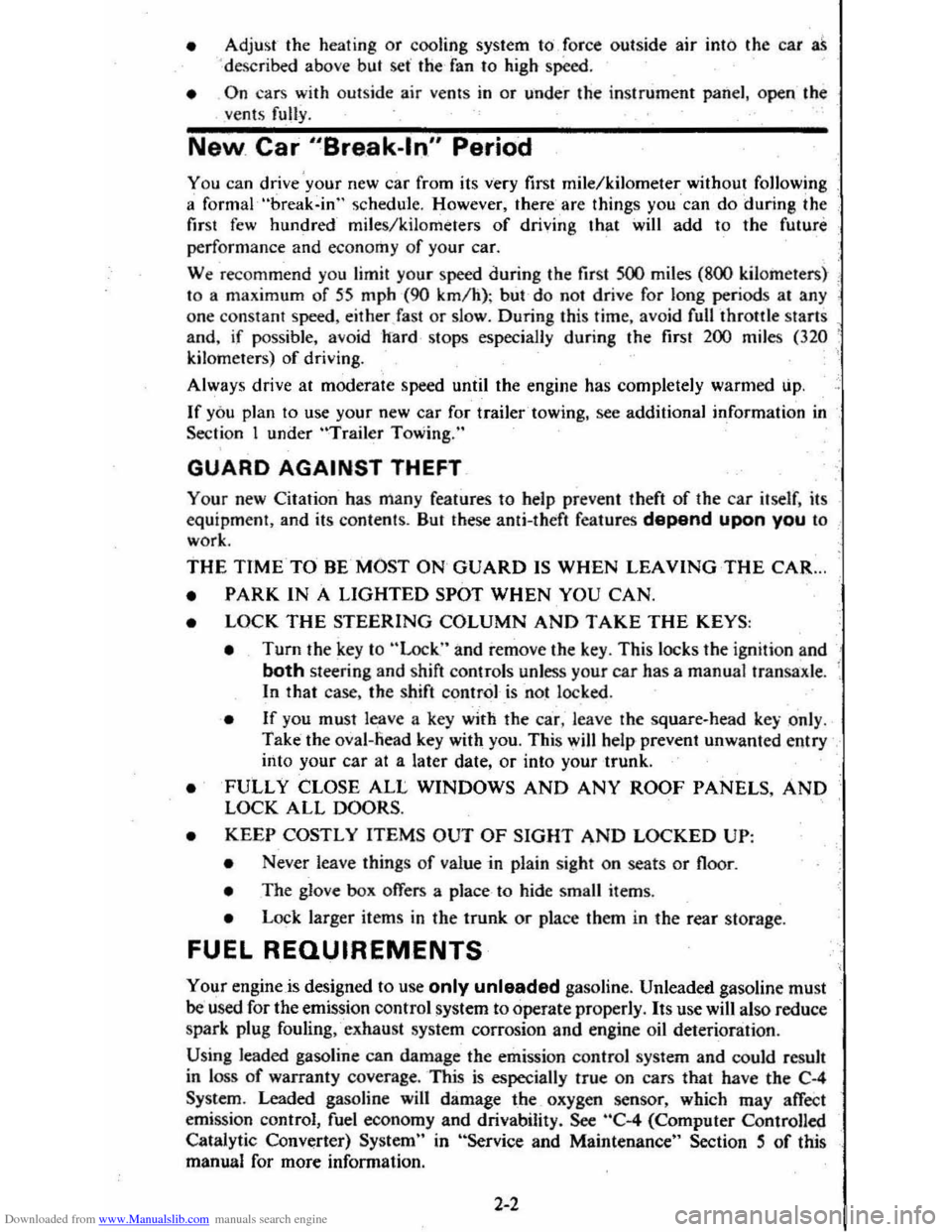
Downloaded from www.Manualslib.com manuals search engine • Adjust the heating or cooling system to force outside air into the car as . d esc ribed abo ve bUI set the fan to high speed .
• On cars with outside air vents in or under the instrument panel, open the vents fully.
New. Car "Break-In" Period
You can drive your new car from its very first mile/kilometer without following .
a
formal"break~in" schedule. However, there'are things you can do during the
fir st few hundred miles/kilometers of driving that will add to the future
perf orm ance and econ omy of your car.
We recommend you limit your speed during the first 500 miles (800 kiJomet ers) ~
to a maximum of 55 mph (90 km/h) ; but do not drive for long period s al any'
one constant speed, either Jast
or slow. During this time , avoid fulllhronJe start s _ and, if possible, avoid h"ard stops especially during the first 200 miles (320
kilometers) of driving.
Always drive at moderate speed until the engine has completely warmed
up.
If yo u plan to use your new car for trailer towing, see additional information in Section 1 under "Trailer Towing."
GUARD AGAINST THEFT
Your new Citation has many features to help prevent theft of the car itself, its
equ ipment, and its content s. But these ami-theft features depend upon you to
work .
THE TIME TO BE MOST ON GUARD IS WHEN LEAVING THE CAR ...
• PARK IN A LIGHTED SPOT WHEN YOU CAN.
• LOCK THE STEERING COLUMN AND TAKE THE KEYS,
•
Turn the key to "Lock," and remove the key. This locks the igniti on and
both steering and shift connols unless your car has a manual transaxle.
In that case, the shift control- is not locked .
• If you must leave a key with the car, leave the square-head key .only .
Take the oval-Read key with you. This will help prevent unwanted entry into your car at a later date, or into your -trunk.
•
FULLY CLOSE ALL WINDOWS AND ANY ROOF PANELS. AND LOCK ALL DOORS.
•
KEEP COSTLY ITEMS OUT OF SIGHT AND LOCKED UP,
•
Never leave things of value in plain sight on seats or noor.
• The glove box offers a place -to hide small items.
• Lock larger items in the trunk or place them in the rear storage .
FUEL REQUIREMENTS
Your engine is designed to use only unleaded gasoline. Unleaded gasoline must
be' used for the emission control $ystem to operate properly. Its use will also reduce
s park plug fouling , -exhaust system corrosion and engine oil deterionition .
Using leaded gasoline can damage the emiS5ion control system and could result
in loss of warranty coverage. This is especially true on cars that have the C-4
System . Leaded gasoline will damage tbe oxygen sensor, which may affect
emission control, fuel economy
and drivabiJity . See "C-4 (Computer Controlled
Catalytic Converter) System" in "Service and Maintenance" Section 5 of this
manual for more information.
2-2
Page 20 of 95
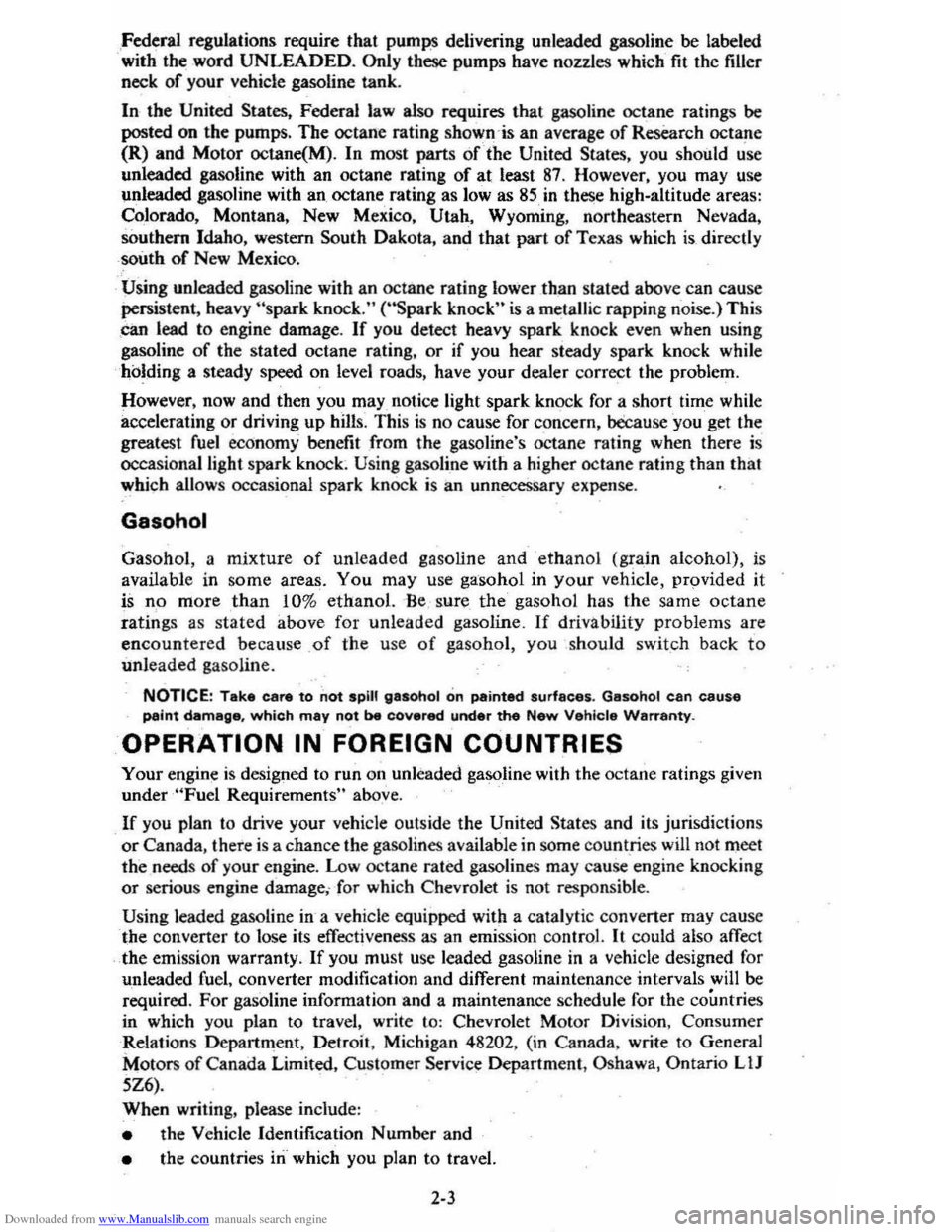
Downloaded from www.Manualslib.com manuals search engine Federa1 regulations require that pumps delivering unleaded gasoline be labeled
with the word UNLEADED. Only these pumps have nozzles which fit the filler
neck of your vehicle gasoline tank.
In -the United
States, Federal law also requires that gasoline octane ratings be
posted on the pumps. The octane rating shown -is an average of Research octa!1e (R) and Motor octane(M). In most parts of the United States, you should use
unleaded gasoline with an octane rating
of at least 87. However, you may use
unleaded gaSOline with an octane rating as low as 85 in thes:e high-altitude areas:
Colorado , Montana, New Mexico, Utah. Wyoming. northeastern Nevada.
southern Idaho, western South Dakota, and that part
of Texas which is directly south of New Mexico.
Using unleaded gasoline with an octane rating
lower _than staled above can cause persistent , heavy "spark knock." (''Spark knock" is a metallic rapping noise.) This
can lead to engine damage. If you detect heavy spark knock even when using
gasoline of the stated octane rating, or if you hear steady spark knock while
holding a steady speed on level roads, have your dealer correct the problem.
However. now and then you may
notice light spark knock for a short time while
accelerating or driving up hills. This is no cause for concern, because you get the
greatest
fuel economy benefit from the gasoline's octane rating when there is occasional light spark knock~ Using gasoline with a higher octane rating than that
which allows occasional spark knock is an unneceSsary expense.
Gasohol
Gasohol , a mixture of unlead ed gasoline and ethanol (grain alcohol), is
available in some areas. You may use gasohol in your vehicle, provided it
is
no more than 10% ethanol. 'Be: sure the gasohol has the same octane
ratings as stated above for unleaded gasoline. If drivability problems are
encountered because _of the use of gasohol, you should switch back to
unleaded gas oline.
NOTICE: Take care to not spill gasohol on painted surfaces. Gasohol can cause paint damage, which may not be covered under the New Vehicle Warranty.
OPERATION IN FOREIGN COUNTRIES
Your engin~ is designed to run on unleaded gasoline with the octane ratings given
under '''Fuel Requirements" above .
If you plan to drive your vehicle outside the United States and its jurisdictions
or Canada, there is a chance the gasolines available in some count,ries will not meet the needs of your engine. Low octane rated gasolines may cause engine knocking
or serious engine damage,: for which Chevrolet is not respon sible .
Using leaded gasoline
in-a vehicle equipped with a catalytic converter may cause
the converter to lose its effectiveness as an emission control.
It could also affect
the emission warranty.
If you must use leaded gasoline in a vehicle designed for
unleaded fuel, converter modification and different maintenance intervals will be
required.
For gasoline information and a maintenance schedule for the countries
in which you plan to travel, write to: Chevrolet Motor Division, Consumer
Relations Department, Detroit, Michigan 48202, (in Canada , write to General
Motors of Canada Limited. Customer Service Department , Oshawa, Ontario LlJ
5Z6).
When writing, please include :
• the Vehicle Identification Number and
• the countries in which you plan to travel.
2-3